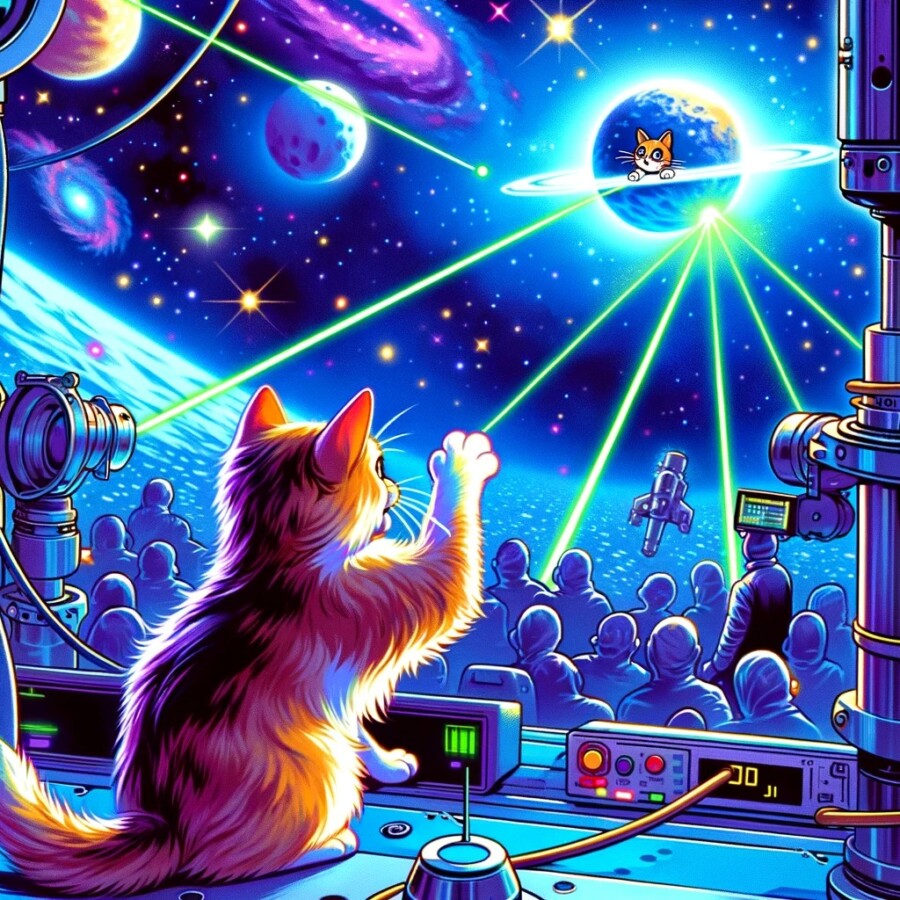NASA sent a very clear video of a cat named Taters from space to Earth using a special light beam. The video traveled a very, very long way, much farther than the moon is from us. It was sent from a spaceship that went up into space on a big rocket. NASA wants to use this light beam to talk to faraway parts of space better.
The video was caught by a big telescope and then sent to a NASA place in California without waiting. Even though the video came from so far away, it got here faster than videos usually load on the internet at home. NASA is trying to find better ways to send big videos and pictures from space to Earth. They think this new way of sending things with light is a big step for talking to spaceships that go to other planets.
NASA did something really cool by sending a video of a cat with a light beam from space. The cat video went a super long way, 19 million miles, and got to Earth on December 11. A big rocket put the spaceship with the video into space. NASA thinks this new way of sending things with light will help us talk to places in space that are very far away.
Original news source: Nasa beams cat video from deep space with laser (BBC)
🎧 Listen:
Slow
Normal
Fast
📖 Vocabulary:
| 1 | transmitted | Sent from one place to another |
| 2 | beam | A straight line of light that can be seen |
| 3 | telescope | A big tool that makes far away things look closer and bigger |
| 4 | spacecraft | A vehicle that travels in space |
| 5 | lunar | Related to the moon |
| 6 | communication | The way people or things share information |
| 7 | captured | Taken or grabbed |
| 8 | facility | A place where special work or activities are done |
| 9 | instantaneous | Happening or done right away, without any delay |
| 10 | innovative | New and creative, not done before |
| 11 | celestial | Having to do with the sky or outer space |
| 12 | interplanetary | Between different planets |
Group or Classroom Activities
Warm-up Activities:
– Charades
Instructions: Divide the class into two teams. Write down key words from the article on small pieces of paper and put them in a hat. One student from each team will come up to the front of the class and choose a word from the hat. They must then act out the word without speaking, and their team members have to guess what word it is. The team that guesses correctly gets a point.
– News Summary
Instructions: In pairs, students will take turns summarizing the article to their partner. They should include the main points and important details. After each partner has summarized, they can compare their summaries and discuss any differences or missing information.
– Opinion Poll
Instructions: Write three statements related to the article on the board. For example: “Sending videos from space is a waste of resources,” “NASA’s new light beam technology is groundbreaking,” “Cats are the best animals to send videos of.” Have students choose one statement and stand on a spectrum line in the classroom, with one end representing “strongly agree” and the other end representing “strongly disagree.” Students can discuss their opinions with each other and try to convince others to change their position.
– Vocabulary Pictionary
Instructions: Write down key words from the article on small pieces of paper and put them in a hat. Divide the class into small groups. One student from each group will come up to the front of the class and choose a word from the hat. They must then draw a picture on the board to represent the word, while their group members try to guess what word it is. The group that guesses correctly gets a point.
– Pros and Cons
Instructions: Divide the class into small groups. Assign each group a topic related to the article, such as “Sending videos from space” or “Using light beam technology.” Have the groups brainstorm and discuss the pros and cons of their assigned topic. After a few minutes, each group can present their findings to the class and engage in a class discussion about the different perspectives.
🤔 Comprehension Questions:
1. What did NASA send from space to Earth using a special light beam?
2. How far did the video travel?
3. How did NASA send the video to Earth?
4. Did the video arrive faster than videos usually load on the internet at home?
5. What is NASA trying to find better ways to do?
6. How far did the cat video travel?
7. How did NASA put the spaceship with the video into space?
Go to answers ⇩
🎧✍️ Listen and Fill in the Gaps:
NASA (1)______ a very clear video of a cat named (2)______ from space to Earth using a special (3)______ beam. The video traveled a very, very long way, much farther than the moon is from us. It was sent from a spaceship that went up into space on a big rocket. NASA wants to use this light beam to talk to faraway parts of space better.
The video was caught by a big telescope and then sent to a (4)______ place in (5)______ without waiting. Even though the video came from so far away, it got here faster than videos usually load on the internet at (6)______. NASA is trying to find better ways to send big (7)______s and pictures from space to Earth. They (8)______ this new way of sending things with light is a big step for talking to (9)______ that go to other planets.
NASA did something really cool by sending a video of a cat with a light beam from space. The cat video went a super (10)______ way, 19 million miles, and got to Earth on (11)______ 11. A big rocket put the (12)______ with the video into space. NASA thinks this new way of sending things with light will help us talk to places in space that are very far away.
Go to answers ⇩
💬 Discussion Questions:
Students can ask a partner these questions, or discuss them as a group.
1. What do you think about NASA sending a video of a cat from space to Earth?
2. How would you feel if you received a video message from space?
3. Do you like watching videos of cats? Why or why not?
4. What do you think is the coolest thing about sending videos from space?
5. How do you think the cat in the video felt being sent from space to Earth?
6. Do you think it’s important for NASA to find better ways to send videos and pictures from space? Why or why not?
7. What do you think is the benefit of using light beams to send messages to spaceships in faraway places?
8. How do you think the people at NASA felt when the cat video arrived on Earth?
9. Have you ever seen a rocket launch? If yes, how did it make you feel?
10. What do you think is the most interesting thing about space?
11. If you could send a video message from space, what would it be about?
12. Do you think sending videos from space is a big step for exploring other planets? Why or why not?
Individual Activities
📖💭 Vocabulary Meanings:
Match each word to its meaning.
Words:
1. transmitted
2. beam
3. telescope
4. spacecraft
5. lunar
6. communication
7. captured
8. facility
9. instantaneous
10. innovative
11. celestial
12. interplanetary
Meanings:
(A) Related to the moon
(B) New and creative, not done before
(C) Having to do with the sky or outer space
(D) A big tool that makes far away things look closer and bigger
(E) A straight line of light that can be seen
(F) A place where special work or activities are done
(G) Between different planets
(H) Happening or done right away, without any delay
(I) A vehicle that travels in space
(J) Taken or grabbed
(K) The way people or things share information
(L) Sent from one place to another
Go to answers ⇩
🔡 Multiple Choice Questions:
1. How did NASA send the video of the cat from space to Earth?
(a) Using a special light beam
(b) Using a big rocket
(c) Using a spaceship
(d) Using a big telescope
2. How far did the video of the cat travel?
(a) 19 million miles
(b) 1 million miles
(c) 100 miles
(d) 10 miles
3. Where did the video of the cat come from?
(a) The moon
(b) California
(c) The internet
(d) A spaceship
4. How did the video of the cat get to Earth faster than videos usually load on the internet?
(a) It was sent using a big rocket
(b) It was sent using a special light beam
(c) It was caught by a big telescope
(d) It was sent from a spaceship
5. What is NASA trying to find better ways to send from space to Earth?
(a) Cats
(b) Rockets
(c) Big videos and pictures
(d) Telescopes
6. What does NASA think this new way of sending things with light is a big step for?
(a) Talking to people on Earth
(b) Sending things to the moon
(c) Sending things to California
(d) Talking to spaceships that go to other planets
7. What did the spaceship with the video of the cat get put into?
(a) A big telescope
(b) A big rocket
(c) A spaceship
(d) California
8. What date did the video of the cat get to Earth?
(a) December 1
(b) November 11
(c) December 11
(d) November 1
Go to answers ⇩
🕵️ True or False Questions:
1. The video was sent from a spaceship that was launched into space on a big rocket.
2. The video did not travel a very long way, even farther than the distance between the moon and Earth.
3. Despite coming from such a far distance, the video arrived faster than videos usually load on the internet at home.
4. NASA sent a video of a cat named Taters from space to Earth using a special light beam.
5. The video was captured by a large telescope and then sent to a NASA facility in California without delay.
6. NASA is not working on finding better ways to send large videos and pictures from space to Earth.
7. NASA does not believe that this new method of sending things with light is a significant advancement in communicating with spaceships that travel to other planets.
8. NASA does not want to use this light beam to communicate with faraway parts of space more effectively.
Go to answers ⇩
📝 Write a Summary:
Write a summary of this news article in two sentences.
Check your writing now with the best free AI for English writing!
Writing Questions:
Answer the following questions. Write as much as you can for each answer.
Check your answers with our free English writing assistant!
1. How did NASA send a video of a cat named Taters from space to Earth?
2. How far did the video of the cat travel to get to Earth?
3. How did NASA catch the video of the cat from space?
4. Did the video of the cat get to Earth faster than videos usually load on the internet at home?
5. Why does NASA think sending things with light is a big step for talking to spaceships that go to other planets?
✅ Answers
🤔✅ Comprehension Question Answers:
1. What did NASA send from space to Earth using a special light beam?
NASA sent a video of a cat named Taters from space to Earth using a special light beam.
2. How far did the video travel?
The video traveled a very, very long way, much farther than the moon is from us.
3. How did NASA send the video to Earth?
NASA sent the video using a special light beam that was caught by a big telescope and then sent to a NASA place in California.
4. Did the video arrive faster than videos usually load on the internet at home?
Yes, the video arrived faster than videos usually load on the internet at home.
5. What is NASA trying to find better ways to do?
NASA is trying to find better ways to send big videos and pictures from space to Earth.
6. How far did the cat video travel?
The cat video traveled 19 million miles.
7. How did NASA put the spaceship with the video into space?
NASA put the spaceship with the video into space using a big rocket.
Go back to questions ⇧
🎧✍️✅ Listen and Fill in the Gaps Answers:
(1) sent
(2) Taters
(3) light
(4) NASA
(5) California
(6) home
(7) video
(8) think
(9) spaceships
(10) long
(11) December
(12) spaceship
Go back to questions ⇧
📖💭✅ Vocabulary Meanings Answers:
1. transmitted
Answer: (L) Sent from one place to another
2. beam
Answer: (E) A straight line of light that can be seen
3. telescope
Answer: (D) A big tool that makes far away things look closer and bigger
4. spacecraft
Answer: (I) A vehicle that travels in space
5. lunar
Answer: (A) Related to the moon
6. communication
Answer: (K) The way people or things share information
7. captured
Answer: (J) Taken or grabbed
8. facility
Answer: (F) A place where special work or activities are done
9. instantaneous
Answer: (H) Happening or done right away, without any delay
10. innovative
Answer: (B) New and creative, not done before
11. celestial
Answer: (C) Having to do with the sky or outer space
12. interplanetary
Answer: (G) Between different planets
Go back to questions ⇧
🔡✅ Multiple Choice Answers:
1. How did NASA send the video of the cat from space to Earth?
Answer: (a) Using a special light beam
2. How far did the video of the cat travel?
Answer: (a) 19 million miles
3. Where did the video of the cat come from?
Answer: (d) A spaceship
4. How did the video of the cat get to Earth faster than videos usually load on the internet?
Answer: (b) It was sent using a special light beam
5. What is NASA trying to find better ways to send from space to Earth?
Answer: (c) Big videos and pictures
6. What does NASA think this new way of sending things with light is a big step for?
Answer: (d) Talking to spaceships that go to other planets
7. What did the spaceship with the video of the cat get put into?
Answer: (b) A big rocket
8. What date did the video of the cat get to Earth?
Answer: (c) December 11
Go back to questions ⇧
🕵️✅ True or False Answers:
1. The video was sent from a spaceship that was launched into space on a big rocket. (Answer: True)
2. The video did not travel a very long way, even farther than the distance between the moon and Earth. (Answer: False)
3. Despite coming from such a far distance, the video arrived faster than videos usually load on the internet at home. (Answer: True)
4. NASA sent a video of a cat named Taters from space to Earth using a special light beam. (Answer: True)
5. The video was captured by a large telescope and then sent to a NASA facility in California without delay. (Answer: True)
6. NASA is not working on finding better ways to send large videos and pictures from space to Earth. (Answer: False)
7. NASA does not believe that this new method of sending things with light is a significant advancement in communicating with spaceships that travel to other planets. (Answer: False)
8. NASA does not want to use this light beam to communicate with faraway parts of space more effectively. (Answer: False)
Go back to questions ⇧













